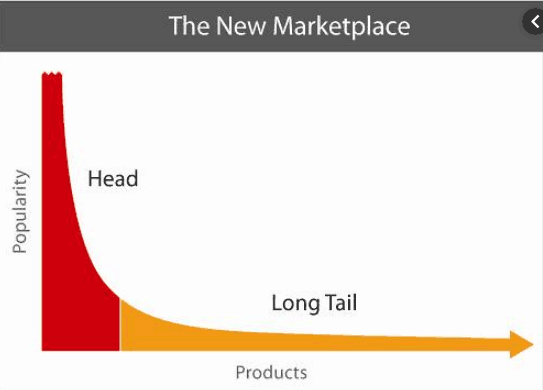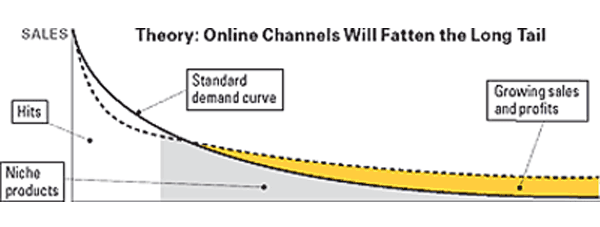It is amazingly been 15 years now since Chris Anderson, editor of Wired magazine, wrote an article on what he called the “long tail” effect, which grew into the 2006 book “The Long Tail: Why the Future of Business Is Selling Less of More.”
It was highly influential.
The basics of the long tail concept are as follows: When the sales of almost every company's products are plotted with sales revenues represented on the Y-axis and the number of SKUs on the X-axis, almost always it looks something like the chart shown below.
Gilmore Says.... |
 |
| A SKU that sells less than once a week in each store might sell quite a few each week if demand is consolidated across the country. |
 |
What do you say? |
|
| Click here to send us your comments |
| |
|
|
|
A relatively few number of SKUs generate a large amount of the revenue, with medium and then slow movers adding less and less to sales, so that the full graph of the numbers can be said to have a head (large volume SKUs), transforming into a tail-looking portion of the curve that trails off through the very slowest moving SKU.
Now, there is nothing new in that thinking. Many years ago I did some data analysis for new distribution center projects, and it is almost like an iron law that 80% or so of sales at the unit level will come from something like 20% of the SKUs, and the reverse.
I have even seen a few cases where it is almost closer to where the top 20% of SKUs represent closer to 90% of the units sold.
Hence often never-ending debates in companies about which SKUs should be pruned from the product portfolio, and analysis tools such as gross margin return on inventory (GMROI) to weed out unprofitable products.
And that pruning effort – especially important historically as new SKUs tend to be furiously added by marketing at most companies – often faces resistance in some sales and marketing quarters, amid fear of either (a) losing market share generally; and/or (b) concern B2B customers especially will drop or reduce the line if the seller doesn't stock a full assortment, including the very slow movers.

What made Anderson's insight take on this unique and useful was his view how all this was changing as a result of the Internet.
Pre-internet – let's say roughly before 2000 – consumer products were sold almost exclusively through retail channels of all sorts. That is key for two reasons.
First, the retail channel presents a true constraint in terms of physical shelf space. Only so many SKUs in a category will be stocked and displayed.
Second, there are many costs associated with that distribution model, from shipping to the retail DC by the manufacturer and then to the store by the retailer, and in terms of inventory carrying costs. I've seen data many times on the incredible percent of products at large retail outlets that move just one time per week or less on average.
But the products sit there on the shelf nonetheless, causing many forecasting and replenishment challenges as well (e.g., slow movers still get replenished in full case quantities).
This all changes in an ecommerce world, Anderson noted. First, there are much fewer constraints in storing products in comparatively cheap distribution center space versus a retail shelf.
Second the internet and direct-to-customer shipping allows the seller to aggregate demand across the entire market. So, a SKU that sells less than once a week in each store might sell quite a few each week if demand is consolidated across the country.
These two things together mean that (a) there would be still more products in the tail, making it longer; and (b) the tail would also grow fatter (more sales per SKUs in the tail), because customers could buy products that more precisely meet their needs and find more of these products through search technologies, as shown in the second graphic below.

All of that meaning that long tail SKUs together increasingly really add up to something meaningful, and could be increasingly profitable individually and collectively when sold through ecommerce. The "80/20" principle would no longer hold.
Those thoughts as a prelude to some recent musings I have had on how supply chain generally and Amazon specifically are impacting long tail thinking and execution.
So consider Home Depot, which carries I believe more than a hundred thousand SKUs in its giant stores. Many of those are long tail, slowing moving products, but Home Depot carries many marginal SKUs because it knows if customers come in and can't find what they are looking for they may not come back the next time.
But in recent years Home Depot has built three ecommerce DCs, which stock something like one million SKUs. These hundreds of thousands of additional SKUs are by definition long tail products, but now demand for them is aggregated across three major facilities.
But while those three ecom DCs gave Home Depot two-day ground shipping to an huge percent of the US population, that wasn't enough in Amazon world.
So now Home Depot is building out almost 200 local fulfillment centers that can provide next day or same day deliveries in many markets – for fast moving SKUs in the head not the tail, though I assume there will also be some cross docking capabilities as part of that mission.
An interesting application of long tail thinking indeed. I will also quickly reference the "endless" aisle concept and vendor drop shipping that add even more SKUs to a retailer's assortment.
But then you have Amazon, ever pushing the envelope. I suspect but do not know that Anderson's long tail vision imagined these slow moving and niche SKUs being fulfilled from centralized distribution facilities.
That would imply shipping of at least a couple of days, and cost for faster service.
But then Amazon stands that model on its head, with its tremendous build out of its fulfillment center network, now at something like 400 facilities of various kinds in the US alone.
In April, Amazon announced it was transitioning its Prime service benefits to offer next day shipping for free, from the previous two-day program. It also just spent $800 million just in Q2 to build the needed capabilities.
Almost hard to fathom, Amazon is saying as the program rolls out, 10 million SKUs will be available in many markets for next day or same day delivery.
How is this even possible? So rather than aggregating demand across the nation and shipping more centrally, Amazon is positioning millions of SKUs very close to the customer and fulfilling rapidly, almost as fast as going to a retail store to get what you want – which they likely wouldn't stock anyways.
It's like it is following the long tail model, but turning it upside down.
I recently had a laptop power cord go out on a Saturday morning, and was flying out of town Sunday night. Amazon had the laptop family-specific power cord nearby, and got it to my house by mid-Sunday afternoon, in plenty of time for my trip.
I almost could not believe that was possible.
And add one more thing: As Art Mesher, inventor of the "Three V's of Supply Chain" noted a couple of years ago at a CSCMP conference the role of Amazon algorithms in determining what products are displayed and an what sequence, with search result that are no doubt what is best for Amazon.
With Amazon controlling give or take about 50% of US ecommerce, that means a vendor's long tail – or even fast moving – products will thrive or shrivel depending Amazon presentation of the search results.
Those search results (including "customers also bought, etc." are in fact the new shelf space allocation.
All of which is to say Chris Anderson's innovative thinking on the long tail is being morphed in ways he likely didn't imagine by the supply chain.
We are in a logistics era comparable to the sea change from Henry Ford and the assembly line.
What is your view of the Long Tail? Is Amazon turning it upside down? Let us know your thoughts at the Feedback section below.
Your Comments/Feedback
|
|
Robert DeDomenico
Founder and CEO, CargoFish |
Posted on: Sep, 13 2019 |
|
| Chris Anderson's book, "The Long Tail", was recommended to me by a professor in my graduate studies at Drexel University in 2010, and became the inspiration for the development of a new distribution technology, the likes of which few can truly fathom from description alone: CargoFish. The change to be is not yet even percieved, but soon will be. The age of the circulatory system for FMCG will change everything. |
|
Ambarish Modak
Focus Area Manager in Retail APJ, SAP |
Posted on: Sep, 17 2019 |
|
I agree that the paradigm has shifted drastically with e-commerce. No product is long tail anymore. This is possible primarily due to the huge amount of data crunching that is done by e-commerce giants. The algorithms and data science helps to forecast what kind products should be kept in which locations of the country so that is more likely to be sold. Add to this the cost of warehouse is far lower than that of retail store. So Amazon is opening smaller DCs closer to customer location and carry those SKUs that can be precisely get sold in that region and the algorithm is continuosly learning from the order fulfillment experience.
|
|
Omer Bakkalbasi
Chief Innovation Officer, Solvoyo Co |
Posted on: Sep, 17 2019 |
|
| Good article on a difficult topic, Dan. Long-tail has been around for a long time in the spare parts world. Unfortunately, the analytical rigor and the management experience in this domain lacked behind those of High-tech, CPG and Retail companies...at least historically. However, with e-commerce product portfolios with millions of SKUs and looooong-tails, key concepts from the spares world, enabled by mind-boggling analytics power in the cloud, is gaining importance again: intermittent demand forecasting, parametric and non-parametric approaches, AI/ML, multi-echelon deployment, inventory pooling, etc. One successful case study on long-tail is in Forbes:
https://www.forbes.com/sites/stevebanker/2019/01/09/ecommerce-retailer-reaps-large-rewards-following-supply-chain-planning-implementation/
|
|
|